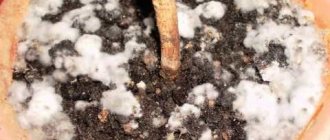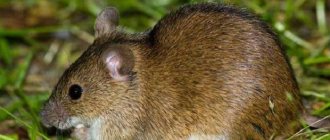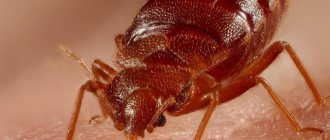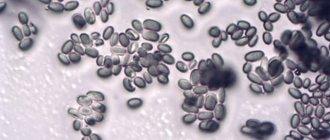Not only we, but also many pests are not averse to tasting sweet and juicy carrots.
They spoil the fruits and make them unsuitable for further storage, so all gardeners should know why carrots are wormy and what to do about this phenomenon. The reasons for the appearance of wormholes on root crops are trivial: various pests eat them and even breed their offspring in such tunnels. If timely measures are not taken after the appearance of the “pioneer” insects, they will soon take root in all carrot beds. And then you will have to forget about large and juicy carrots, and instead you will get fruits spoiled by moves. There is no point in bringing them into the cellar - vegetables with a damaged outer shell will not last. In addition, there is absolutely nothing left to eat there: after you cut off the spoiled pulp, there will be little left. There is only one thing: to identify and destroy the pest in time. So, the reason for the appearance of wormholes on carrots is the vigorous activity of such pests:
- carrot fly;
- wireworm;
- exclamation scoop.
Why are carrots wormy and what to do if they are attacked by a carrot fly
Small dark-red insects with porches do not pose a danger to root crops until they lay larvae there. It is the offspring of the fly that are engaged in “laying labyrinths”, because they need food to grow. They start from the top of the fruit, gradually gnawing holes along its entire length, as a result of which the plant begins to wither while still in the garden.
However, you can notice the infestation of carrot beds by a fly even at the initial stage - the tops near the head acquire a purple color.
You can fight carrot flies by spraying the plantings:
- infusion of wormwood or tomato tops;
- concentrated (2%) saline solution;
- insecticides (Decis, Actellik).
To prevent the appearance of flies, sprinkle tobacco dust mixed with ash over the area before sowing carrots. Insects cannot tolerate this smell. They also do not like the strong aromas of spicy crops, so plant onions or garlic next to the carrots.
Root nematode
A pest such as the root-knot nematode is especially troubling to gardeners. This is a white, small worm, 1.5 mm in size. It lives on the surface of the ground. It is difficult to notice; the moves the pest makes are very small.
Nematodes lay eggs in root crops. Numerous bumps appear on the surface of the carrot. The bulges increase in size. Worms emerge from them, which filter the juice and eat the pulp of the root crop.
The root-knot nematode is heterosexual. Males have a round shape and are 2 mm long. The body of the female is 1 mm. It has a pear-shaped shape. At one time, the female can lay up to 2.5 thousand eggs. A pair of nematodes produces up to 8 generations per year. The eggs take up to 2 months to develop. Main symptoms:
| № | Helpful information |
| 1 | numerous small holes on the soil surface |
| 2 | yellow carrot tops |
| 3 | deformed roots with numerous cones |
Fighting worms is difficult. They tolerate low temperatures down to -30 C, and die from high temperatures of 100 C and above. Insecticides are used for control, but the difficulty of use is that the parasites quickly get used to the chemicals. The drugs must be changed every time.
It is impossible to completely get rid of nematodes. What to do to preserve root vegetables? To combat parasites, chemicals and biological methods are used. When choosing a site for carrots, take into account crop rotation.
If the soil is contaminated with worms, it is recommended to treat it with formaldehyde or methyl bromide. These substances are very caustic and greatly disrupt the microflora in the soil. After treatment, the soil is not used for sowing.
More on the topic: How are Longe Rote carrots grown?
Work is being carried out to restore its chemical and biological composition and improve fertility.
Modern scientists have developed new drugs against nematodes. They do not disturb the composition of the soil so much, but their effectiveness is slightly reduced. Gardeners are recommended to use the following drugs:
- “Fitoverm” – concentration 4 ml/l; treat the soil before sowing, irrigate until completely moistened; this amount is enough to process 1 m2; for insects use a concentration of 2 ml/l; spray bushes and soil; the volume is intended for an area of 5 m2;
- “Actofit” – concentration 0.5 kg/m2; a similar norm can be used for “Fitoverm” if the soil damage is total; the funds are introduced 2-3 days before sowing, the soil is dug up into 2 shovels;
- iodine solution - take 5 ml of the drug per 3 liters of solution; irrigate snow during melting; Iodine passes with melt water into the deep layers of the soil, prevents the development of bacteria, viruses, and resists insects and nematodes.
When growing carrots in industrial conditions, pesticides are used: “Carbofuran”, “Marshal”, “Aldoxycarb”. The drugs are toxic and require a period of discarding. They can be used against insect pests. Prepare a solution from 7 ml/10 l of water.
Igor Nikolaev
auto RU
To combat nematodes, a more concentrated solution is required. It is often applied together with mineral fertilizers, 15 ml/10 l.
If carrots are eaten by white worms, then it is no longer possible to save the fruits; non-standard methods are used to treat the soil. Manure, compost, sugar and sugar production waste are introduced. Saprophytes develop on these substances. These are plant-organisms. They provoke the appearance of predatory fungi, nematodes and mites that eat gall parasites. They do not attack root crops. The site can be used in 3-4 years.
Carrots with white worms are not eaten. It is dangerous for humans. Parasites produce toxins that cause poisoning. Root crops are burned. Nematodes are killed by high temperatures.
Experts warn that it is impossible to destroy all worms. This takes a lot of time. It is necessary to regularly cultivate the soil and plants.
More on the topic: What characterizes Boltex carrots?
How dangerous are wireworms for carrots?
Unlike the carrot fly, it is not so easy to notice this pest, because the above-ground part of plants at the initial stage often remains unchanged. In addition, the wireworm itself is a worm that lives in the soil, so it is not visible from above. It is located immediately in the fruits themselves, feeding on them. But in places where there are already fruits, the carrots begin to rot. Then the tops also fade.
If you discover the wireworm late, when the carrots are already growing, you can spread potatoes soaked in a special preparation Bazudin in the spaces between the rows. The pest will eat the poisoned tuber and die. Immediately after sowing, you can sprinkle ammonium nitrate over the beds. But it’s best to add ammonium sulfate to the digging in the fall. Or the same Bazudin mixed with sand.
Causes of pests on carrots
Most often, the appearance of a certain type of pest depends on the conditions created and suitable only for it.
Generally speaking, the appearance of pests is influenced by the lack of crop rotation. Carrots are planted in the same place for several years in a row. As a result, parasites get used to the fact that this place is safe and there is always something to profit from.
One of the reasons for the appearance of pests may be an unsuccessfully chosen place for a carrot bed. It should not be placed in the shade or separately from the entire garden. It is better not to plant carrots next to coniferous plants.
Another reason for the appearance of pests on carrots may be the use of the same feeding or fertilizer. Or their timely introduction into the soil.
Well, the last reason is unsuitable climatic conditions - extreme heat or cold and dampness. Unfortunately, the gardener cannot influence this in any way. But it can slightly regulate climatic conditions by watering.
Gardener questions
Who eats carrots in a garden bed in the ground
Most often it is a carrot fly. She lays larvae in carrots, and they gnaw out thin, deep tunnels. When the invasion is severe, black depressions appear on the carrots. After this, the fruits deteriorate, acquire a bitter taste and can become infected with fungal diseases.
Wireworms also make narrow and deep passages. It happens that the mole cricket eats up all the pulp, leaving only the peel of the carrot.
If the bites are clearly visible to the naked eye, then most likely they are mice.
Who is nibbling carrots from above?
If the tops are not very damaged, and it looks more like they have dried out, then these are insect pests such as aphids, fleas or cutworms. They are difficult to notice with the naked eye and you need to look very closely to find them, because they are small and green. And if the tops seem to have been bitten, then there may be slugs. Carefully examine the surroundings, maybe you will find their hideout. It happens that hares or mice cause such damage.
Who cuts carrot tops in the garden
Mole crickets and fall armyworm caterpillars are capable of this. The mole cricket devours everything within a diameter of one and a half meters from its nest. And if you really notice a circle in your ruins, then try digging in the center. You can find her nest. Naturally, it must be destroyed immediately.
And cutworm caterpillars, when they begin to hatch from eggs, are very voracious and can travel a long distance compared to their size.
It happens that it is hares or mice sharpening their teeth.
Types of carrot rot
Soft rot (mucous bacteriosis).
You can often notice the first signs of the disease in the garden: the leaves darken and wither, parts of the tops may be covered with mucus. However, most often the disease manifests itself after storing the crop. The insides of the root crop soften, turning into a characteristic putrefactive mass with an unpleasant odor, while the skin may remain intact. Sometimes the first sign of soft rot is dark spots with an unpleasant odor that quickly increase in size. Soft rot tends to quickly move from diseased root crops to healthy ones and can destroy the entire crop in storage. Damaged carrots should be removed from storage immediately.
soft rot of carrots
Alternaria (black rot).
A fungal disease develops especially actively in high humidity. In damp and cold summers it can cause the death of the tops: the leaves turn brown and black, starting from the tips, and quickly rot. During storage, Alternaria manifests itself by the appearance of dry, dark, depressed spots, on which a greenish coating of mold may be detected. Gradually, dense rot of an intense black color develops in their place. Like other fungal infections, Alternaria quickly spreads in storage. The infection is also dangerous because it is easily transmitted through infected seeds and leads to seedlings becoming infected with blackleg.
black rot of carrots
Fomoz (dry, brown rot).
A characteristic sign of phomosis is the appearance of spots or transverse stripes, first at the top of the root crop and gradually spreading over the entire surface. The spots are dark, depressed, with a brownish tint; fungal spores may be visible in the form of dark dots. Over time, deep ulcers and white rot appear in their place.
Scab (rhizoctoniosis)
A disease of fungal origin, it manifests itself on root crops with gray spots, which then acquire a purple tint. As the disease progresses, the carrots dry out and may be additionally affected by various types of rot.
Sclerotinia (white rot)
A common fungal disease that affects a wide variety of crops, even trees and shrubs. On carrot root crops it manifests itself as softening and watery tissue in the absence of a putrefactive odor. A dense white coating, reminiscent of cotton wool, quickly forms on the affected areas. Sometimes there may be no plaque; the disease is determined only by the progressive softening of the roots. The spread of the disease in the storage facility is facilitated by high temperature (above +20 °C) and humidity of more than 90%.
white rot of carrots
Methods for solving the problem
First, let's look at the most effective methods of dealing with wireworms:
Now let's look at the most effective measures to combat carrot flies. To begin with, immediately after harvesting, you need to dig up the soil, turning over the top layer. This way, you will not allow the larvae to get out if they remain in the soil. In addition, you should approach the process of watering the carrot crop with particular seriousness - excess moisture can provoke the active development of the pest (observe the measure).
In addition, correct crop rotation of carrots can make a significant contribution to the fight against carrot flies: they should be planted next to tomatoes, onions, and garlic.
Try traditional pest control methods
If you find high pest activity in your beds, you should use “heavy artillery”: hot peppers or tobacco. Both products are equally effective at repelling flies, and incredibly quickly (in just a couple of days they will leave the area). You just need to dust the carrot beds with ground red/black pepper or ground tobacco.
The carrot fly is very afraid of wormwood, so the plant can be used as the main ingredient for preparing a repellent solution. Cut the wormwood and fill the bucket with it. Then fill the plant with water. When the water has cooled, divide the solution into three parts and filter it. Then dilute with water, bringing to 8 liters. We spray both the plants themselves and the row spacing with the resulting solution.
This concludes the material. As you can see, there are no unsolvable problems. If you know effective methods of pest control and, most importantly, apply them correctly in practice, the crop will “survive” until the time of harvest. Good luck and a rich harvest!
How to protect carrots from rodents?
Unfortunately, insects and their larvae are not the only ones who want to snack on carrots.
Root crops also need to be protected from rodents - primarily from mice and rats. If there is any free space left in your garden, plant a black elderberry bush - it repels midges and mosquitoes, and the substances that its roots release into the soil are poisonous to rats and mice. Branches of black elderberry, simply stuck into the ground next to cultivated plants, will also help against voracious rodents, but they will have to be periodically replaced with fresh ones.
Mice do not like the smell of mint and anise, which means you can safely plant these healthy herbs near carrot beds.
Do not forget to also harvest carrots on time in accordance with the variety being grown. Leaving ripe root vegetables in the garden increases the risk of pest damage.
We wish you success and great harvests!











